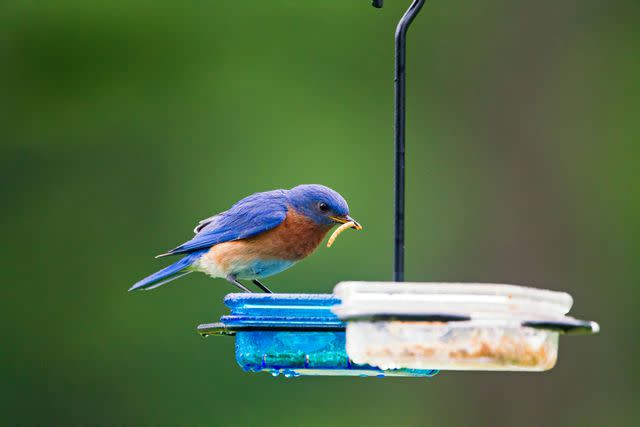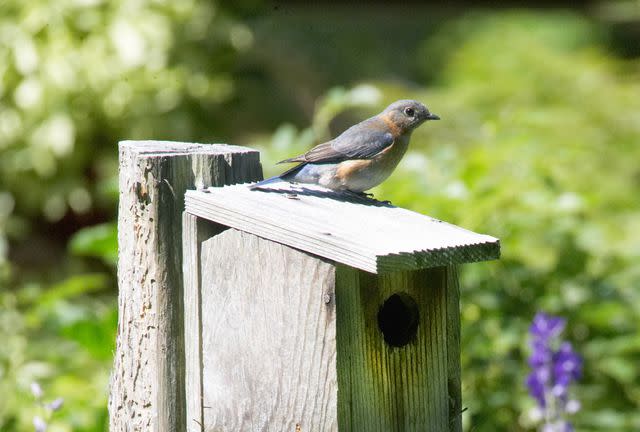How to Attract Bluebirds to Your Yard: 11 Must-Know Tips
These tips on how to attract bluebirds will help you create a welcoming habitat for these beautiful birds.
How to attract bluebirds to your yard is similar to attracting any other songbird: provide for their basic needs such as food, shelter, and water, and they will come. However, there are some specifics to know about enticing bluebirds. For example, setting out a bird feeder may seem like a no-brainer, but the type of food it contains makes a big difference to the birds you want to see hanging out in your backyard. Follow these tips to learn how to attract bluebirds to your yard.

Rob Cardillo
What Are Bluebirds?
Three types of bluebirds in North America are found in distinct regions. The eastern bluebird lives as far north as Canada, east of the Rockies, and as far south as the Gulf of Mexico. The mountain bluebird is at home in many landscapes from Alaska to the Great Plains and Central Mexico; it is often found in higher elevations. Western bluebirds live along the California coast to many areas in the Southwest as well as west of the Rockies.
Meet Our Expert
Chris Earley is an adjunct professor of integrative biology at the University of Guelph and the author of several books, including Feed the Birds: Attract and Identify 196 Common North American Birds.
TJ Savereno is a senior forestry and natural resources extension agent with Clemson University.
Tips for Attracting Bluebirds
1. Offer favorite foods.
Bluebirds have a varied diet of insects and fruits, so they aren’t drawn to bird feeders with seeds. Instead, offer bluebirds live or freeze-dried mealworms. “Mealworms are beetle larvae that can be bought from some pet stores,” says Chris Earley, a biology professor at the University of Guelph.
Place the dried mealworms in a hopper feeder shaped like a house with large holes in the sides that the bluebird can enter, he says, or put live ones in a dish. “Place a smooth steep-sided dish with mealworms in it—the sides prevent them from escaping—on a deck railing or platform bird feeder,” says Earley.
Limit the amount of mealworms you offer during the nesting season, Earley advises. “Baby bluebirds will not get the nutrition they need from only mealworms, so it is recommended to just put a few out once or twice a day,” he says. “In the winter, this is not an issue since the bluebirds are not nesting.”
TJ Savereno, an extension agent at Clemson University, adds that bluebirds also may be enticed by other foods such as suet, peanut hearts, raisins, blueberries, and chopped apples.
2. Provide water.
Bluebirds benefit from a water source for drinking and bathing. “Although bluebirds get most of the water they need from the foods they eat, they will drink from bird baths,” says Savereno. Bathing in a bird bath helps keep their feathers clean and keeps them cool in hot weather, he adds.
Related: The 15 Best Bird Baths of 2023 for a Stylish, Bird-Friendly Garden
It’s not only a bird bath that bluebirds will use. According to Earley, “Bluebirds will bathe and drink in bird baths, recirculating streams, or pond edges as long as the water is not too deep.” So how much water should be in the basin? He says about an inch with clear views around the bathing spot is perfect. Don't forget about the colder months. “Heated bird baths in winter may be used,” says Earley. Savereno points out, “Remember to clean your bird bath regularly and your feeders too.”
3. Plant berry-producing natives.
Bluebirds' diets change based on the season and what is readily available. “Bluebirds feed primarily on ground-dwelling insects, spiders, and other soft-bodied invertebrates during warm months, and berries and fruits through the winter,” says Savereno. Consider adding natives that produce berries in the winter to your landscape.
“Plant berry-producing native trees, shrubs, and vines that grow well in your area,” says Earley. “In the east, American bittersweet vine, staghorn sumac, and dogwoods are all good choices for wintering eastern bluebirds.”
Several native trees also produce berries. “Landscaping that includes species like black gum, Carolina cherry laurel, dogwoods, eastern red cedar, and American holly will provide some of those fruits that persist into the winter,” says Savereno.
Related: 19 Berry-Producing Plants That Will Attract Birds to Your Yard
4. Leave dead trees.
Despite our tendency to keep backyards clean and organized, nature prefers some disorder. If possible, leave dying or dead trees as a source of habitat for bluebirds. “One of the most limiting factors for bluebirds is nesting cavities,” says Savereno. “Leave dead trees and branches, as long as it is safe to do so.”
Other bird species may create spaces and nests for bluebirds, too. “Woodpeckers will create new cavities that may be used in subsequent years by bluebirds for nesting,” he says. Another benefit of not removing old branches is that they provide a hunting perch for bluebirds, says Savereno.
5. Keep nesting material around.
Bluebirds need certain materials to create their nests. “Bluebirds build their nests from pine needles and grasses,” says Savereno. “They sometimes line the nest with fine grasses, hair, and feathers.” If pine trees and grasses aren't around the area, you can leave pine straw or garden straw stuffed in a suet holder during nesting season in your region.

Jay Wilde
6. Put up a birdhouse.
Bluebirds use a birdhouse during the nesting season in late winter and early spring (depending on region). “Bluebirds are cavity nesters, so building a bird box and putting it up in your yard might attract them during the nesting season,” says Earley. Make sure it’s well-designed and meets their nesting needs to encourage them to take up residence. “Proper box design, construction, mounting, and maintenance is critical,” says Savereno.
Due to habitat loss, a lot of the success in the recovery of bluebirds is due to placing artificial nest boxes in the appropriate habitat, Saverno adds. What’s the best style birdhouse for bluebirds in your region? “Check out a local nature club to find the best box design for your area,” says Earley. Savereno adds, “A wealth of information is available from the North American Bluebird Society.”
Related: The 8 Best Birdhouses of 2023 to Attract Nesting Birds
7. Don’t use pesticides.
One way to keep bluebirds nearby is to avoid using pesticides for garden or lawn maintenance. Pesticides reduce the food sources for bluebirds, and they have to go elsewhere to find bugs to feast on. “Excessive use of insecticides greatly reduces the number of insects that bluebirds depend on for food, not to mention native pollinators and other beneficial insects,” says Savereno.
Choose companion planting or integrated pest management (IPM) as a safer alternative for dealing with pests. “Implementing a program of integrated pest management can help reduce the dependence on these insecticides,” says Savereno.
8. Provide a perch near open space.
Because bluebirds eat a lot of insects, they need plenty of open space to catch them successfully. “Bluebirds hunt insects by sitting on a perch and watching for movement on the ground, then swooping down to catch their prey,” says Savereno. “They need a relatively open habitat with a scattering of trees for perches, though they will also use power lines, fence lines, and fence posts.”
10. Keep cats away.
Research shows a high percentage of bluebirds are killed by cats each year. “Outdoor cats are the biggest threat; keep them inside,” says Earley. If keeping your cat inside isn't possible, consider buying a brightly colored collar for your feline to protect bluebirds and other wildlife. The colors on the collar clue in bluebirds and give them some time to fly away.
11. Mark your windows.
Windows can be unsafe for bluebirds since the reflection in the glass looks like real landscape to the birds. Marking your windows helps the birds see the glass. Earley recommends using Feather Friendly dots on the outside to prevent bluebirds or other birds from crashing into the window. If you’re putting up a bird feeder, place it away from windows. “If your house has a large picture window, place the feeder within 3 feet of the window to minimize bird and window collisions, or move your feeder to another side of the house, away from large windows,” says Savereno.
Frequently Asked Questions
Where’s the best place to put a bluebird feeder?
Place the feeder in a sunny location with lots of open space nearby. Bluebirds are particularly fond of nesting on the outskirts of a large, manicured lawn that has not been treated with pesticides. Avoid putting the feeder in an area of deep shade. Also, avoid placing the feeder close to the house near windows to prevent the birds from crashing into the glass.
Which colors will attract bluebirds?
Bluebirds are attracted to the color blue, likely because they are attracted to their own color. They have excellent vision and can see all colors but don’t seem to have any other color preferences.
What time of year should I put up a bluebird house?
You can put up a birdhouse any time of year, but ideally, put the house up in early spring. Many bluebirds use a birdhouse during nesting season, which is typically in February and March, depending on your geographical region. Also, some bluebirds that stay during the winter instead of migrating may use a birdhouse.
For more Better Homes & Gardens news, make sure to sign up for our newsletter!
Read the original article on Better Homes & Gardens.

